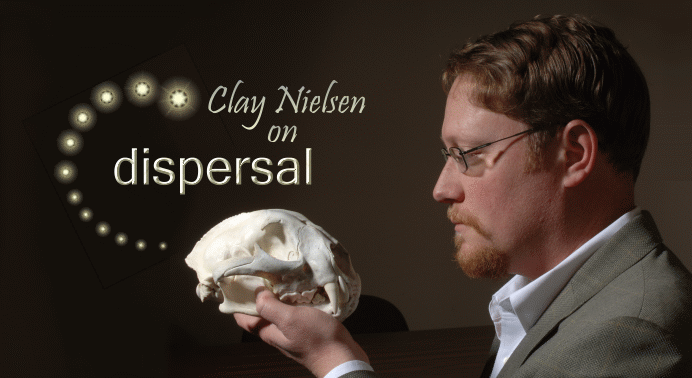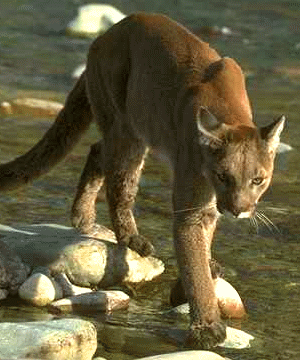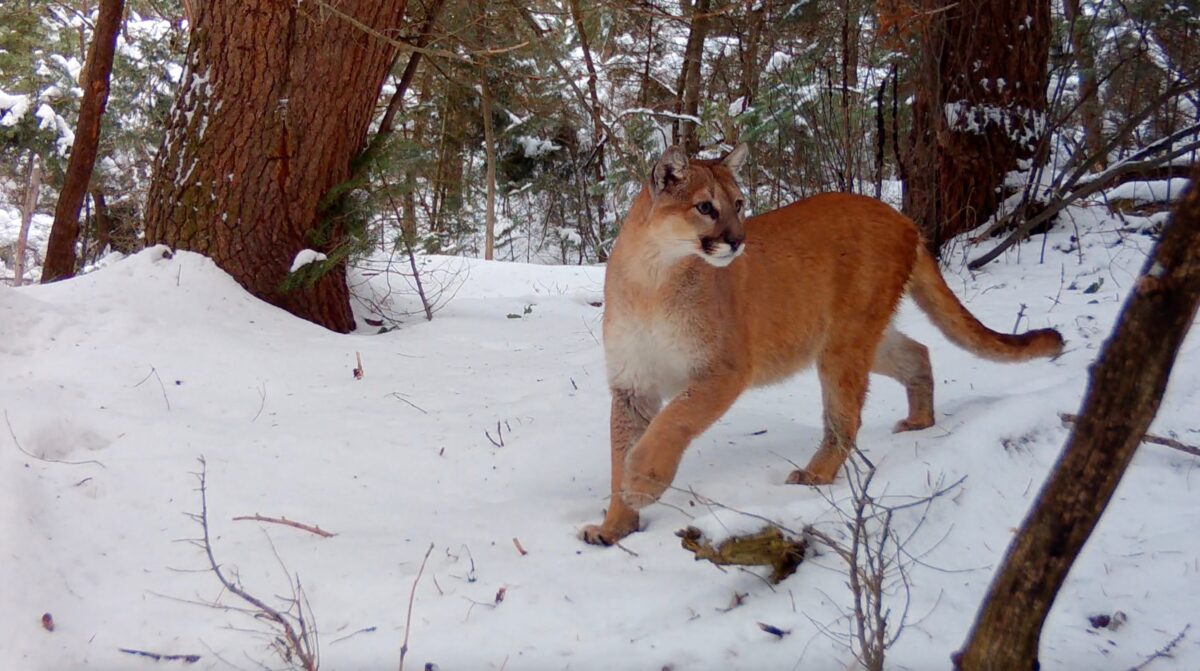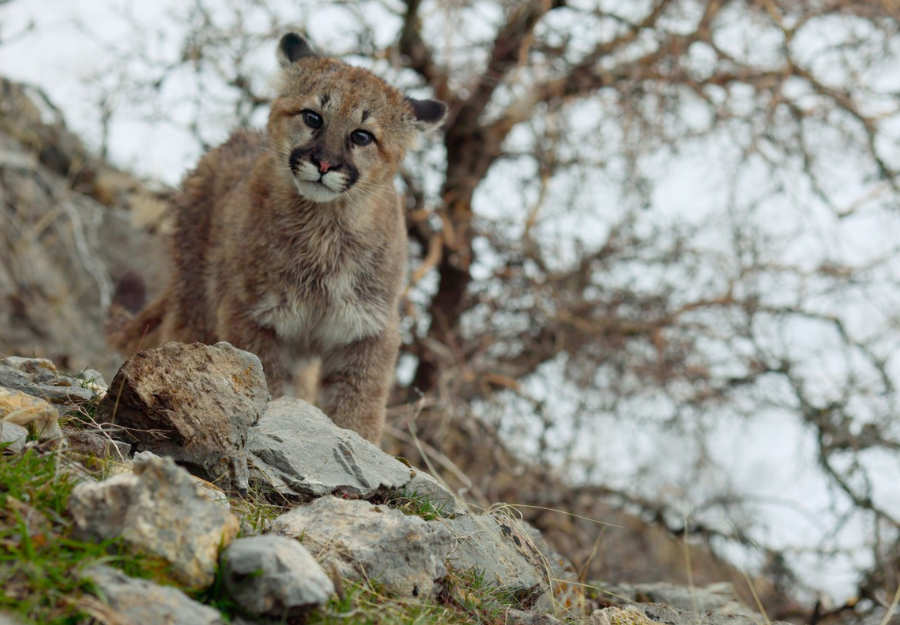
ON AIR: Biologist Clayton Nielsen Considers Mountain Lion Corridors into the Midwest
An Audio Interview with Craig Fergus, MLF Volunteer
 Listen Now!
Listen Now!
Listen to the interview from MLF’s ON AIR program, podcasting research and policy discussions about the issues that face the American lion.
Transcript of Interview
Intro: Welcome to On Air with the Mountain Lion Foundation, broadcasting research and policy discussions to understand the issues that face the American lion.
Craig: Hello. I’m Craig Fergus, and with me today is wildlife biologist Clayton Nielsen. Clay is director of scientific research for The Cougar Network and is also a professor at the University of Southern Illinois. Is that at Carbondale?
Clay: Yep, Carbondale.
Craig: Fantastic. And how long have you been a professor there?
Clay: Oh, I’ve been a professional level scientist and professor now for 7 years here at SIU.
Craig: That’s great. And your recent work has involved mapping potential habitat corridors for mountain lion dispersal into the Midwest. Is that correct?
Clay: Yes, that’s true. I’ve been conducting research on mountain lions in the Midwest for about 6 or 7 years now.
Craig: Awesome. Then can you tell us a little bit more about your research, and how that data’s being used, and who it’s being used by?
Clay: What I am doing research-wise looking at cougar expansion in the Midwest involves a couple different main foci. Number one, in working with The Cougar Network we are documenting confirmed instances of cougar presence in the Midwest and have been doing so with data since about 1990. And we’ve been gathering this information, consulting with cougar scientists across the country, and looking at the validity of confirmations. So when I say confirmation I mean real hard evidence, not sightings but carcasses, DNA evidence, pictures or video of cougars in mid-western states that can be verified. And we have documented over 300 different confirmations of cougars in the mid-western states since the early 1990’s.
Now, a second focus of my work then involves trying to predict potential habitat and dispersal corridors for cougars that may be coming into the Midwest. And this is something that interests me as a wildlife biologist. It’s the first logical step to understanding the future for this animal. The Midwest is a region that was once suitable for cougars. They were essentially extirpated from the region. And what sort of habitat exists now? And certainly we found that ah, about 8 percent of the Midwestern strip of states down the middle of the country, about 8 percent is highly suitable habitat. And those areas are largely found in areas with little human presence, forest cover, and steep topography.
Craig: So that leads in to another one of my questions. How do you determine what makes for good mountain lion habitat? Both in terms of the actual environmental physical characteristics of the area, and then from a functional standpoint, how you go about finding where these areas are?
Clay: Well, we did the work entirely through computer modeling and used geographic information systems. And normally when wildlife biologists do this type of research, he or she is trying to tie habitat preferences to individual animals through the use of radio telemetry or some sort of research where the animal, by its use of the landscape that we can measure, tells us what habitats are important.
Well in the case of cougars in the Midwest, we don’t have many around. We have animals that are dispersing through the region, we don’t have breeding populations except the Black Hills and western North Dakota and extreme western Nebraska, so we couldn’t rely on the animals themselves telling us what good habitat is. So we sent out surveys to establish cougar biologists and then also, mid-western wildlife biologists who know mid-western landscapes. And we gave them a variety of habitat variables, such as land cover, so is the land cover agricultural? Is it forest cover? Is it wetland cover? And other various habitat variables such as topography, human density, distance to roads and distance to streams. And we had our expert biologists rank those values. And then we used their rankings in a statistical method to develop a large-scale habitat map of potential habitat suitability for cougars in the region using geographic information systems.
Craig: Now are these areas you’re talking about dispersal corridors only — as you mentioned mountain lions moving eastward into the Midwest — or are they also areas that could support breeding populations? Are those two things the same or are the mountain lions looking for something different in terms of habitat for these different purposes?
“whether or not enough females can disperse into the Midwest and then these females and males find each other, is the real issue that is going to dictate whether or not we have breeding populations
Clay: Well, the basis of our habitat analysis is to understand, kind of the basis for potential cougar expansion into the region, so it pertains not only to identifying areas of good habitat for dispersal, but also areas of good habitat if populations should ever become at a level where there are breeding numbers or anything like that. So the baseline habitat map that we’ve created is useful for just about anything involving cougar presence or expansion.
Craig: Okay. And so far where have you found to be the most important corridors for mountain lions already moving into the East or to potentially be moving to the East in the future?
Clay: Well, our research is predictive modeling. So the corridors that we have created are more theoretical, are more areas of likely-use that animals would take if they were going between western populations and then points in the Midwest. And those areas are along various riparian corridors and areas were we have smaller blocks of, say, forested cover, that are not large enough probably to harbor breeding populations ever, but serve as stepping stones across a largely unsuitable and agricultural landscape.
Craig: So would you say then that agricultural areas are the biggest impediment towards movement for mountain lions? Or, I’d imagine that cities and urban areas would be also a major block for mountain lion dispersal?
Clay: Yeah. Cougar habitat suitability in our model was less in areas where we had intensive row crop agriculture and urban sites. So those are the areas that these animals would probably avoid. Now, of course out west, cougars and humans are in contact in many, many places. But I don’t think that would necessarily be the case here in the Midwest, especially for a pioneering population. They’re not gonna find much prey in our corn fields and soybean fields of the Midwest. And urban areas are not going to be highly suitable for them either.
Craig: And reading from The Cougar Network website, it seems like one of the driving factors for eastward expansion of mountain lions is juvenile males moving away from their home ranges into new areas. So how and when could we see these individuals settling into breeding populations? And what kind of factors can make this happen?

Clay: Well you know, certainly the predominate dispersers are male, and all evidence will point to that. And that follows with what we know about cougar ecology. And so if we have a bunch of roaming males with no females they’re likely to continue to roam and keep looking for them, which may mean they travel until they get killed by some source here in the Midwest. Or they may head back towards where they came from. It’s really difficult to say. So the obvious important thing is females. And whether or not enough females can disperse into the Midwest and then these females and males find each other, is the real issue that is going to dictate whether or not we have breeding populations, and a lot of that information is yet unknown. We do know that the Black Hills of South Dakota though has resulted in a few known documented female dispersers, and that the western North Dakota population has probably broken off from the Black Hills population which was a recolonization event. So such things are possible. It’s just a question of when they will happen over what period of time and it’s really dependent on female dispersal.
Craig: Okay. And another thing I came across on the website was a distinction between mountain lion sightings that you thought were due to natural movement as opposed to sightings that you thought were either a planned relocation or some kind of accidental release. Specifically, there were some sightings in New York and the Quebec area of Canada. You seem to think that these were probably accidental releases of some kind. Why is it important to focus on the natural movements as opposed to these possible planned relocations?
Clay: Oh, I don’t, I don’t know if any one’s more important than the other. As a scientist I’m interested more in the natural expansion of these populations, because that’s really what’s driving this issue in the Midwest.
Craig: Okay. And how do you see laws and policies of states where this mountain lion expansion is occurring influencing that expansion, and impacting the movement of mountain lions? And also vice versa: how do you see these new mountain lion populations influencing the laws and policies of these Midwestern states?
Clay: Well, the Midwest has been devoid of large predators for over 100 years now and they were extirpated from here because of conflicts — or perceived conflicts — with humans regarding livestock and game species as well. So, the issue of this animal and then others such as wolves and black bears as well, reemerging in the Midwest is one that is perplexing policymakers and wildlife agencies. Some agencies don’t really know what to do yet and are waiting to see whether or not these animals actually naturally re-colonize. Other states I think are considering changing their laws. A couple mid-western states, Iowa and Illinois, where I reside here in Illinois, those two states do not have cougars protected in any way shape or form because the wildlife laws were written — certainly in Illinois, I don’t remember in Iowa — but the wildlife laws were written after these animals had been extirpated, so they’re not even recognized as a potential species. And I’m not sure if Iowa’s changing their mind and revising their laws. But other states I think are kind of waiting to see whether this phenomenon really takes hold because frankly, state agencies budgets are so strapped, that having to deal with another species and another issue is something that’s really tough to afford right now. And I think it’s probably a good idea for these agencies to kind of wait and see given that they have a lot of other challenges on their plate to deal with already.
Craig: So given some of your thoughts there, and the fact that your project and its data can be helpful in determining where cougars may or may not be in the future, what is a way that the average person listening to this program can help out specifically with your project or with kind of the goals of your project as a whole?
Clay: Well, the average person can ah send me $500,000 and that would help my research considerably. [laugh] Um, the average person can’t do much um unless, except contribute financially. [laugh]
Craig: Well, how about cougar sightings and confirmations? How do you bring in that type of information?
The Cougar Network employs two classifications for “Confirmations”:
CLASS 1 CONFIRMATIONS:
1. The body of a dead cougar, or a live captured animal.
2. Photographs (including video).
3. DNA evidence (hair, scat, etc.)*
CLASS 2 CONFIRMATIONS:
1. Track sets verified by a qualified professional.
2. Other tangible, physical evidence verified by a qualified professional (i.e., prey carcasses, microscopic hair recognition, thin-layer chromatography of scat).
*DNA evidence alone should be interpreted with caution. Confirmation from two independent laboratories and/or photographs from remote cameras at predetermined DNA collection sites will enhance confidence in cougar activity.”
The Cougar Network
Clay: Um, The Cougar Network website and the 40 or 50 different agency contacts that we have with state agencies throughout the Midwest and East are our main sources of information. So when — and usually these folks are the ones who are actually gathering the data — and say someone gets a picture in Vermont or a track photo, or something like that, that meets our criteria, we’re looking for tracks and photos and carcasses and that sort of thing, then that information filters down into The Cougar Network. Or someone will send us a print, a footprint, and we’ll send it off to Harley Shaw who’s on our Board of Directors, who’s a noted cougar biologist for many years. And he’ll look at the information: say yes, this is a cougar print, or no, it’s not. And so the general public, by reporting to us through our website or through their state agency, is really the best way that they can help get the information our way.
Craig: Great. Hopefully some folks are out there!
Clay: That’s what you were, that’s probably what you were looking for and not my first smartass answer. [laugh]
Craig: Well, if there are some donors out there listening, then maybe they’ll be able to help you out. So moving forward now, what’s kinda on your plate at the moment and what kind of projects are you looking to do in the future?
Clay: With regards to cougar research?
Craig: Yeah.
Clay. I presume. Okay. Well, I mentioned earlier about how difficult it is to predict when the Midwest may — if and when — the Midwest may become recolonized with cougars. Well I am currently using that habitat map and then some other information from western cougar populations to try to start making those predictions of when cougars may repopulate the Midwest, when there may be breeding populations, how many individuals may exist in those populations, and where those populations are specifically found in the Midwestern states. So that’s one of my major cougar related expansions on this first research effort that I’m trying to finish.
We’ve also started doing some human dimensions work. We did a survey project, surveying residents in Kentucky and North Dakota. So two states, very different parts of the country; North Dakota being on the kind of edge of cougar expansion. Kentucky, the animals haven’t gotten there, even any of our dispersers haven’t shown up there. And so we’re trying to look at human attitudes and perceptions about these animals should they recolonize the Midwest. So those are the two main cougar related items that I’m working on right now.
Craig: Well, those sound like two quite exciting studies.
Clay: Yes, and they’re nearly, nearly complete. So I hope to, we hope to, have some final reports and publications submitted for that work very soon.
Craig: That would be fantastic. I’d be really excited to see those when they come out.
Clay: Sure. Absolutely.
Craig: If somebody else was interested in catching up with those reports, what would be the best way to follow along with your research?
Clay: Um, probably The Cougar Network website has most of the information posted there and that’s a good place to find that. And, you know, we post some of the more scientific stuff is you know, that’s the way that I do my work and it would be better to probably water it down a little bit to the main points, which is generally what we’re talking about here today. And some of that information can be found on The Cougar Network website.
Craig: Well, I think that’s probably a pretty good amount of information for the people out there listening today. Thank you very much for taking time out of your schedule to come talk with us.
Clay: Absolutely, Craig. Happy to be of service.
Craig: Yeah, we really appreciate it, and really appreciate the work you’re doing out in the field.
Clay: Wonderful. If you need anything else from me don’t hesitate to let me know.
Craig: Fantastic. Thanks again for your time.
Closing: [music] This has been a Mountain Lion Foundation On Air broadcast. On Air is a copyrighted production of the Mountain Lion Foundation. Permission to rebroadcast is granted for noncommercial use.




 Facebook
Facebook Twitter
Twitter Send Email
Send Email


